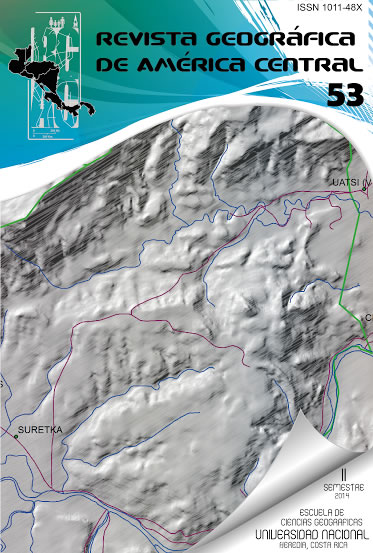PERI-URBAN DYNAMIC: CONSIDERATIONS FOR ITS STUDY IN THE CASE OF COSTA RICA
DOI:
https://doi.org/10.15359/rgac.2-53.7Keywords:
Peri-urbanization, Urban Systems, Peri-urban Interface, Geographic Information System, Costa RicaAbstract
Peri-urbanization allows reconfiguration of urban and rural dynamics from the interaction of social, economic, political, cultural and environmental flows and processes. These processes are studied in the peri-urban interface from the systemic approach, considering elements of the subsystems involved in the geographic configuration of suburban space as developed in the case study of Palacios, Quesada and Zúñiga (2011). The theoretical-methodological peri-urban processes described in this article illustrate some guidelines for the development of peri-urban investigations. These guidelines consider the changing variables such as land use, employment opportunities and popular perception of basic services, subject to the analysis needs of the researcher and the characteristics of the unit of study.
References
Ávila, H. (2004). La agricultura en las ciudades y su periferia: Un enfoque desde la Geografía. Investigaciones Geográficas, Boletín del Instituto de Geografía, UNAM, 53, 98-121. Recuperado de: http://www.igeograf.unam.mx/web/iggweb/publicaciones/boletin_editorial/boletin/bol53/b53art6.pdf
Carvajal, G. (1983). El proceso de Urbanización en la Periferia del Área Metropolitana: Los casos de Turrucares y Monte de la Cruz. Revista Geográfica de América Central, 17-18, 69-97.
Delgado, J. (2003). La urbanización difusa, arquetipo territorial de la ciudad-región. Revista Sociológica, 51, 13-48. Recuperado de: http://www.revistasociologica.com.mx/pdf/5102.pdf.
Departamento de Geografía, Universidad de Costa Rica. (1979). Santa Ana: Un caso de suburbanización en la aglomeración metropolitana. Revista Geográfica de América Central, 9,10, pp.11-78.
Entrena, F. (2005). Procesos de periurbanización y cambios en los modelos de ciudad. Un estudio europeo de casos sobre sus causas y consecuencias. Papers, Revista de Sociología, Universidad de Granada, 78, 59-88. Recuperado de: http://www.raco.cat/index.php/papers/article/viewFile/40273/40561.
Fernández, M. (2006). Planificación estratégica de Ciudades: Nuevos instrumentos y procesos. Barcelona, España: Editorial REVERTÉ. S, A. 147-149. Recuperado de: http://books.google.co.cr/books?id=LvLNRCpPdSgC&pg=PA148&lpg=PA148&dq=brian+berry+teoria+de+sistemas+urbanos&source=bl&ots=GBEuWqEb4B&sig=0f6599RxyPDZJ34yq8jRZxME7Q8&hl=es-419&sa=X&ei=DyjnT66ELoyk8ATGpPm4AQ&sqi=2&ved=0CEwQ6AEwAQ#v=onepage&q&f=false.
Ferrás, C. (2007). El enigma de la contraurbanización. Fenómeno empírico y concepto caótico. EURE, 33(98), 5 - 25. Recuperado de: http://www.scielo.cl/scielo.php?pid=S0250-71612007000100001&script=sci_arttext
Gómez, F. (1985). Geografía urbana de Euskal-Herria: análisis y teorías. Cuadernos de Sección. Historia-Geografía, 5, pp.341-412. ISSN 0212-6397. Recuperado de: http://hedatuz.euskomedia.org/451/1/05341412.pdf
MAG-MIRENEM (1995). Metodología para la determinación de la capacidad de uso de las tierras en Costa Rica. San José, Costa Rica.
Morera, C., Romero, M., Miranda, P., Avendaño, D. & Alfaro, M.. (2007). Análisis del territorio periurbano, actividades ecoturísticas y paisaje de la Gran Área Metropolitana de Costa Rica. Informe final. Asistencia técnica local de apoyo a la gestión del PRUGAM en la GAM.Universidad Nacional, Heredia, Costa Rica [UNA].
Palacios, M.; Quesada, L. & Zúñiga, B. (2011). La dinámica de la Interfaz periurbana, factores y transformaciones espaciales del territorio. El caso de los distritos Concepción y Ángeles del cantón San Rafael de Heredia entre 1989 y 2011. (Tesis inédita de licenciatura). Universidad Nacional, Escuela Ciencias Geográficas, Heredia, CR.
Shütte, O. y Lidth, M. (2010). GAM(ISMO): Cultura y Desarrollo Urbano en la Gran Área Metropolitana de Costa Rica. Cuaderno de Ciencias Sociales, 155, FLACSO: Costa Rica. Recuperado de: http://www.flacso.or.cr/fileadmin/documentos /2010/Cuaderno_155.PDF
Downloads
Published
How to Cite
Issue
Section
License
Proposed policy for journals offering Open Access
Authors publishing their works in the Journal acknowledge and agree to the following terms:
a) Authors retain the copyrights to their works and guarantee the Journal the right to be the first to publish their works, under the Creative Commons License Attribution-NonCommercial-ShareAlike 4.0 International, CC BY-NC-SA 4.0 International (https://creativecommons.org/licenses/by-nc-sa/4.0/deed.es), which allows others to share works upon complying with the acknowledgment of authorship and mention of the Journal as the original publisher of the work.
b) Authors are permitted to separately establish additional agreements for the non-exclusive distribution of the official edition of the work published in the Journal (for example, authors may desire to place the work in an institutional repository or incorporate it into a book that is to published elsewhere) so long they acknowledgment to recognize the Journal as the original publisher. The aforementioned additional agreements must respect the terms of the non-profit character and sharing philosophy of the original license (CC BY-NC-SA 4.0 International, https://creativecommons.org/licenses/by-nc-sa/4.0/deed.es).
c) Authors are encouraged to archive the post-print or editor/PDF version in Open Access repositories.






 REVGEO is licensed under https://creativecommons.org/licenses/by-nc-sa/4.0/deed.es
REVGEO is licensed under https://creativecommons.org/licenses/by-nc-sa/4.0/deed.es
.svg_4.png)

_(1).png)
_(1)_(1)_(1)_1.png)
(2)(1)(1)(1).png)
